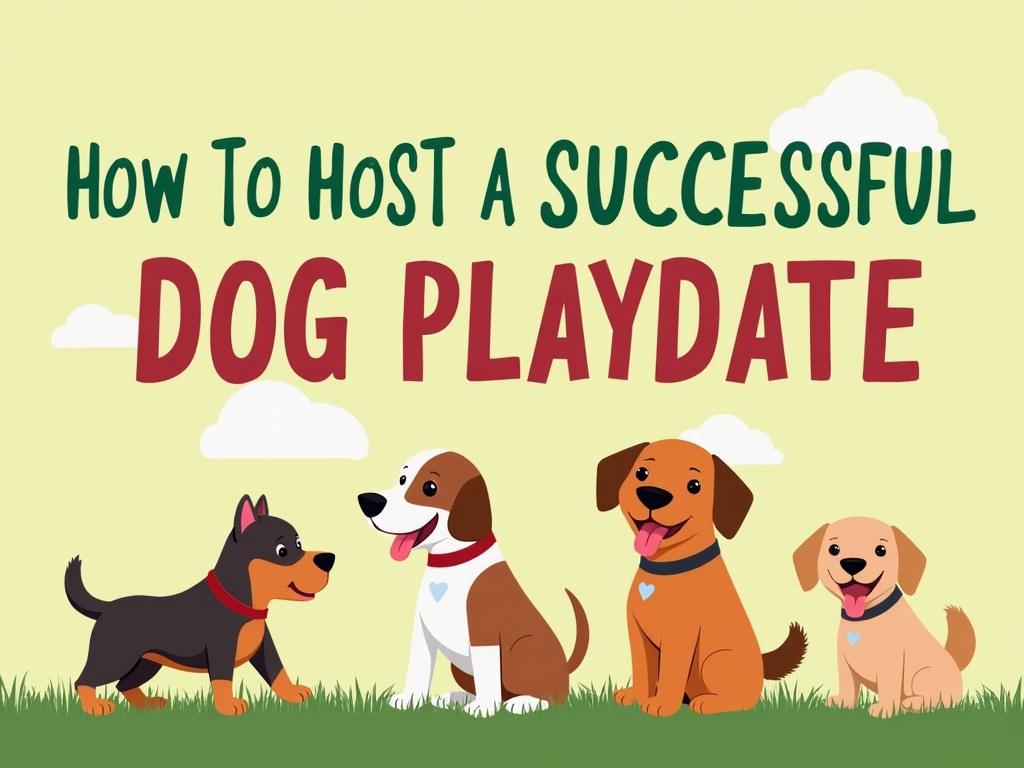How to Host a Successful Dog Playdate: A Comprehensive Guide
Imagine the joyous scene: a flurry of wagging tails, happy barks echoing in the air, and your beloved canine companion romping around with newfound friends. A well-executed dog playdate can be a fantastic way to socialize your furry pal, burn off excess energy, and provide them with valuable mental stimulation. But throwing a few dogs together and hoping for the best isn't enough. A truly successful playdate requires careful planning, thoughtful execution, and a keen understanding of dog behavior. This guide will walk you through every step, ensuring a fun and safe experience for everyone involved – humans and canines alike.
Assessing Your Dog's Play Style and Temperament
Before you even think about inviting other dogs over, it's crucial to honestly assess your own dog's play style and temperament. Is your dog generally friendly and playful with other dogs? Do they have a history of reactivity or aggression? Understanding your dog's personality is the foundation for a successful playdate.
- Consider past interactions: Think about your dog's previous encounters with other dogs. Were they positive, negative, or neutral? How did your dog react in different situations?
- Identify their play style: Some dogs are rough-and-tumble players, while others prefer gentle sniffing and chasing. Knowing your dog's preferred style will help you choose compatible playmates.
- Recognize warning signs: Learn to recognize signs of stress, fear, or aggression in your dog, such as lip curling, growling, stiff body posture, or excessive barking.
- Consult a professional: If you're unsure about your dog's suitability for playdates, consult with a certified dog trainer or veterinary behaviorist. They can provide valuable insights and guidance.
Choosing the Right Playdate Participants
Once you have a good understanding of your dog's needs, you can start thinking about potential playdate participants. Compatibility is key!
Age and Energy Levels
Matching dogs of similar age and energy levels is often a good starting point. A senior dog might not appreciate the boisterous play of a young puppy, and a high-energy dog might overwhelm a more laid-back companion.
Size and Breed Considerations
While size isn't always a determining factor, it's important to consider. A very small dog could be accidentally injured during play with a much larger dog. Certain breeds also have predispositions to certain play styles or temperaments.
Temperament and Play Styles
This is arguably the most important factor. Look for dogs with compatible temperaments and play styles. Dogs who enjoy chasing and wrestling might be a good match, while dogs who prefer gentle sniffing and exploring might do better together. Avoid pairing dogs with known aggression issues or those who exhibit dominant behavior.
The Importance of Introductions
Never just throw dogs together and hope for the best. A proper introduction is essential for a positive experience. Start with a neutral meeting on leash in a controlled environment, such as a park or quiet street. Allow the dogs to sniff each other and assess each other's body language. If the initial meeting goes well, you can gradually move to a more relaxed environment, such as your backyard.
Preparing Your Home and Yard for a Dog Playdate
Creating a safe and stimulating environment is crucial for a successful dog playdate.
Ensuring a Safe Environment
Secure the perimeter: Make sure your fence is secure and free from any gaps or holes.
Remove hazards: Pick up any potentially dangerous objects, such as tools, chemicals, or sharp objects.
Provide shade and water: Ensure there's plenty of shade available, especially on hot days, and provide multiple water bowls.
Designate a safe zone: Create a quiet space where dogs can retreat if they feel overwhelmed or need a break. This could be a crate, a bed, or a secluded corner.
Creating a Fun and Engaging Space
Provide toys: Have a variety of toys available, such as balls, frisbees, and tug-of-war ropes.
Offer different activities: Set up different areas for play, such as a digging pit, an agility course, or a sniffing area.
Rotate toys and activities: Keep things interesting by rotating the toys and activities throughout the playdate.
Supervising the Playdate and Recognizing Potential Issues
Even with the best planning, it's essential to actively supervise the playdate and be prepared to intervene if necessary.
Active Supervision is Key
Don't just sit back and watch. Be actively involved in supervising the dogs' interactions. Pay attention to their body language and intervene if you see any signs of stress, fear, or aggression.
Recognizing and Addressing Problem Behaviors
Bullying: If one dog is constantly harassing or intimidating another, separate them immediately.
Resource guarding: If a dog is guarding toys or food, remove the resource and redirect their attention.
Excessive mounting: While mounting can be a normal part of dog play, excessive mounting can be a sign of dominance or anxiety. Redirect the dog's attention if it becomes excessive.
Signs of stress: If a dog is showing signs of stress, such as panting, pacing, lip licking, or whale eye (when you can see the whites of their eyes), give them a break in the safe zone.
When to Intervene
If you see any signs of aggression: Growling, snapping, or biting should be addressed immediately. Separate the dogs and end the playdate.
If a dog is clearly uncomfortable or distressed: Don't force a dog to participate if they're not enjoying it. Give them a break or end the playdate.
If the play becomes too rough: Some dogs enjoy rough-and-tumble play, but it's important to ensure that everyone is comfortable. If the play becomes too intense, redirect the dogs to a calmer activity.
Ending the Playdate on a Positive Note
The way you end the playdate can have a lasting impact on the dogs' future interactions.
Calm Down Before Departure
Before the dogs go home, give them some time to calm down and relax. This will help them avoid associating departure with excitement and prevent them from becoming overly aroused when they see each other again.
Positive Reinforcement
End the playdate with positive reinforcement. Give the dogs treats and praise for good behavior.
Post-Playdate Assessment
After the playdate, take some time to reflect on how it went. What worked well? What could be improved for next time? This will help you plan even more successful playdates in the future.
Beyond the Backyard: Alternative Playdate Locations
While your backyard can be a great place to host a dog playdate, there are other options to consider as well.
Dog Parks: Pros and Cons
Dog parks can be a great place for dogs to socialize and burn off energy, but they're not always the best option for every dog. Consider the following:
Pros: Access to a large, fenced-in area, opportunities for socialization with a variety of dogs.
Cons: Can be overwhelming for some dogs, risk of encountering aggressive or unvaccinated dogs, potential for unsupervised play.
Doggy Daycares: A Supervised Social Environment
Doggy daycares offer a supervised social environment where dogs can play and interact with other dogs.
Pros: Supervised by trained staff, structured play sessions, opportunities for socialization in a safe and controlled environment.
Cons: Can be expensive, may not be suitable for all dogs (especially those with separation anxiety or reactivity issues).
Organized Playgroups
Consider joining or organizing a playgroup with other dog owners. This allows you to create a consistent group of dogs who are well-matched in terms of temperament and play style.
The Long-Term Benefits of Dog Socialization
Hosting successful dog playdates isn't just about having fun; it's about investing in your dog's long-term well-being.
Improved Social Skills
Regular socialization helps dogs develop better social skills, making them more confident and well-adjusted in various social situations.
Reduced Anxiety and Fear
Socialization can help reduce anxiety and fear in dogs, making them less likely to react negatively to unfamiliar people, dogs, or environments.
Mental Stimulation
Playdates provide valuable mental stimulation for dogs, helping to prevent boredom and destructive behaviors.
Stronger Bond with Your Dog
By actively participating in your dog's socialization, you'll strengthen your bond and build a deeper connection.
Hosting a successful dog playdate requires patience, planning, and a willingness to learn. By following the tips outlined in this guide, you can create a fun and safe experience for your dog and their furry friends, fostering their social development and enriching their lives. So, gather your canine companions, prepare your space, and get ready for a tail-wagging good time!


